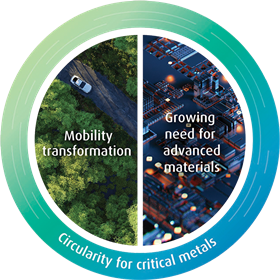At a time when the world is close to a major disaster, essentially by lack of political and economic boldness and vision, the new challenges our society is facing are actually opening the doors to new opportunities.
The rapid development, manufacture and distribution of the Covid-19 vaccine illustrates this relationship between challenges and opportunities, and highlights the central role science and scientists play in improving our quality of life.
At Umicore, we have always been committed to leveraging our unique mix of scientific expertise and experience as a catalyst to drive transformational change for a better world.
Umicore RISE 2030

We understand how the expectations placed on chemists and chemistry are changing, and that the landscape within which they operate is evolving rapidly. In response, we have developed the Umicore RISE Strategy 2030.
As a continuation of pioneering and sustainable approach, this strategy looks to leverage our proven leadership in clean mobility materials and recycling to tackle powerful the powerful global megatrends:
- Mobility transformation
- Growing need for advanced materials and chemicals
- Circularity for critical metals
The world’s pressing challenges can’t be solved by individuals. Interdisciplinary and industrial collaboration plays a major role in tackling these issues head-on. Naturally, chemists have a role to play in this.
Catalytic technologies open new routes to resolve important issues in pharmaceuticals, chemistry, agriculture, energy and many other industry sectors in a resource efficient manner. They also provide solutions to problems such as green synthesis, which is a concern for chemists worldwide.
Helping pharma manufacturing to be greener
To limit the increase in global temperature to 1.5°C by 2050, scientists worldwide are rushing to find effective solutions that deliver solutions to our complex sustainability challenges.
The pharmaceutical and chemical industries are heavy users of scarce resources such as water, energy and metal-based catalysts, for example, as well as hazardous chemicals including solvents, highly active molecules and toxic substances. Yet at the same time, modern society depends on the products of the pharmaceutical industry for combating disease and relieving pain.
To match its commitment to Paris Agreement targets, the pharmaceutical industry must find the right solutions to increase materials circularity and processes efficiency and safety, from new molecule design to current manufacturing.
For decades, catalysts have played an important role in enabling new solutions to meet such challenges. With their potential to increase the rate, conversion and selectivity of chemical reactions, often at lower temperatures, transition metal catalysts are the heroes of the modern chemical industry. And they are the key tools of an environmentally conscious chemistry that aims to transform renewable or recycled chemicals into high-value pharmaceutical products and agrochemicals.

The versatility and efficiency of these precious metal catalysts also come with some drawbacks: high cost and low abundance of the metals. These two challenges can easily be solved with a closed-loop approach to the catalyst life cycle. At Umicore we leverage capabilities across the whole organisation to ensure a holistic approach to catalysis development, manufacturing, use and recycling. We look to understand the entire catalyst lifecycle, including design, characterisation, selection and integration from lab-scale through to industrial scale and end of life refining.
Beside its obvious environment consciousness, the key advantage of this approach is a robust and economically viable solution. Once a closed loop is implemented, most of the metal price is paid only once and recovered metal can be applied as credit toward future purchases of the finished catalyst. As the recovered metal will be stored in metal weight rather than currency, it will be insulated from market fluctuations. Lastly, the metal is secured for the given purpose in an account owned by the pharmaceutical manufacturer, mitigating any supply risk.
Implementing a closed loop will require chemists to work closely with engineers, process and supply chain experts to appropriately plan, design and implement the recovery solution. By involving their catalysis partner early on, a pharmaceutical developer may be able to follow new and more robust reaction pathways, simplify their back-end operations and focus on the many challenges associated with bringing a drug to market.
New catalysts as a tool for more efficient drug discovery
The application of catalysis within the pharmaceutical industry is rapidly evolving. With the availability of novel laboratory tools for characterisation, new approaches to synthesis and advanced computational capabilities, there is enormous potential for advances in catalyst development.
For example, cross-coupling reactions offer the potential to select where new carbon-carbon and carbon–heteroatom bonds are formed, creating new opportunities for synthesis. They can be used to build extensive drug libraries full of potential active pharmaceutical ingredients (APIs), or in lead optimisation and large-scale API preparation. In recent decades, cross-coupling reactions, such as Suzuki–Miyaura and Buchwald–Hartwig, have played a critical role enabling the rapid acceleration of the drug discovery, development and manufacturing process.
Although cross-coupling reactions were first observed over 70 years ago, the true potential of what can be achieved by cross-coupling reactions is still to be uncovered. With Nobel prizes in chemistry being awarded as recently as 2019 for cross-coupling and transition-metal catalysis, we’re only just scratching the surface of the possible. Discoveries are still being made with new substrates and ligands being used to further investigate and understand the mechanics of wide variety of cross-coupling applications. All of this helps scientists to apply cross-coupling reactions as a new solution to the problems they need to overcome.
One such solution came from an industry–academia collaboration with Brad Carrow’s research group at Princeton University, US, which resulted in a new tris(1-adamantyl) phosphine (PAd3) catalyst.1 The PAd3 complex catalyses Suzuki–Miyaura couplings extremely efficiently, with a high turnover number of nearly 20,000.
Umicore’s YPhos ligands2 are another example of the benefits new ligand technologies can bring to cross-coupling reactions. Developed by Viktoria Gessner’s group at Ruhr University Bochum, Germany, these phosphine ligands allow for shorter reaction times with lower energy requirements. The YPhos catalyst technology even performs well at room temperature, leading to a less energy consuming and more catalyst efficient synthetic pathway compared to those offered by existing catalytic methods.

For a more sustainable agriculture
Traditional pesticides, although effective at deterring pests, have been shown to have detrimental effects on public health, the environment and biodiversity.3,4 Research scientists have been exploring alternative options to control pests without the negative implications which come with traditional pesticides.
One promising option is the use of pheromones to distract insects from damaging crops.5 By spraying or diffusing artificial pheromones on the crop fields, insects mating is disrupted, reducing their presence on the crop, allowing it to grow without disturbance.

This technology has been made possible using cross-coupling. The vast majority of insect pheromones are straight-chain hydrocarbon acetates, alcohols and aldehydes with an alkene functional group. Although alternative synthesis methods, such as Lindlar hydrogenation of alkynes or the Wittig reaction, can be used to synthesise the desired molecule, they produce by-products that are toxic and difficult to eliminate, and lack economic efficiency.
Using a ruthenium-based metathesis catalysis with high z-selectivity has changed this pattern. Through metathesis reactions, complex alkenes can be converted into the key pheromones with a high yield. This highly favoured synthesis path enables the use of renewable and cheap starting materials, without generating undesirable by-products. Without the underlying technology enabled by our offerings, this sustainable solution, which offers a financially viable and environment conscious alternative to traditional pesticides, would not be possible.
Precious metal catalysed cross-coupling and metathesis chemistry enables several innovative solutions to a variety of issues faced in many industry fields. To find out more about how Umicore’s offerings can help you, visit: pmc.umicore.com
Christophe Le Ret is global marketing director at Umicore













No comments yet